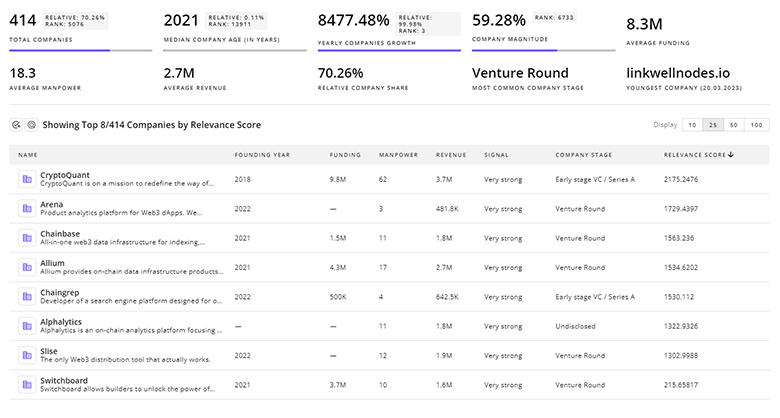
Realtime AI Report
: Analysis on the Market, Trends, and TechnologiesThe realtime AI market is already material: it was valued at $24,050,000,000 in 2024 and is forecast to expand at roughly a 27.8% CAGR, pointing to multi-billion-dollar annual opportunity and platform consolidation pressures for the next decade. Real-time inference and streaming data architectures now power mission-critical use cases—live conversational agents, low-latency perception for robots and vehicles, fraud/risk decisioning, and instant content generation—creating a split market where integrated platform providers and narrowly specialized vendors both find defensible niches, OpenAI makes Realtime API generally available with new features, including MCP support, and launches gpt-realtime, its most advanced speech-to-speech model, AI Trends for 2025 – LinkedIn.
This report was last revised 29 days ago. See a missing piece? Your input can help — contact us.
Topic Dominance Index of Realtime AI
The Dominance Index for Realtime AI delivers a multidimensional view by integrating data from three key viewpoints: published articles, companies founded, and global search trends
Key Activities and Applications
- Real-time conversational AI and voice agents that handle live calls, meetings, and customer interactions with sub-second latency, reducing human load on routine tasks and enabling 24/7 engagement.
- Low-latency perception for robots, industrial automation, and autonomous vehicles where sensor fusion and microsecond motion planning enable safe, adaptive behavior in dynamic environments, Realtime Robotics, Inc..
- Real-time fraud detection, security, and risk decisioning that score events in streaming pipelines and trigger automated mitigations within seconds.
- Live generative media and avatar systems that synthesize photoreal speech, video, and facial motion for customer service, broadcasting, and companion experiences.
- Real-time analytics and predictive maintenance for industrial fleets and smart factories, where streaming telemetry drives immediate corrective workflows.
Emergent Trends and Core Insights
- Agentic, multi-step AI agents are moving into production and orchestrate workflows across services, increasing automation depth and shifting labor from routine tasks to oversight and strategy; this is supported by growing agent platform activity and real-time APIs for voice/multimodal interactions.
- Edge and distributed inference reduce perceived latency and data egress costs, making on-device models and federated approaches essential where privacy or connectivity matter. So what: companies that package a secure, low-latency edge stack shorten integration cycles and win regulated customers.
- Real-time generative pipelines (speech-to-speech, video diffusion for avatars) enable new product classes (live hosts, interactive training) but raise provenance and misuse risks; detection and governance features will become table stakes for enterprise adoption, DeepBrain AI.
- Market economics favor platformization: developer-friendly APIs + pay-as-you-go real-time compute will concentrate demand on providers that combine latency guarantees, observability, and model reliability.
- Privacy and compliance differentiate providers: services that embed data-sovereignty controls, real-time audit trails, and explainability gain trust in healthcare, finance, and public sector deployments.
Technologies and Methodologies
- Streaming pipelines and event-driven architectures (Kafka/Pulsar style) to deliver deterministic, low-variance latency for inference and RAG lookups.
- On-device model optimizations: pruning, quantization, TinyML, and NPU/TPU acceleration to support sub-100ms inference on constrained hardware.
- Retrieval Augmented Generation to bind LLM outputs to fresh, auditable data sources and reduce hallucinations in live agent experiences.
- Reinforcement learning and continual online learning for personalization and UI adaptation in production applications (real-time personalization, flow optimization), flowRL.
- Neuromorphic and spiking approaches for event-driven efficiency where energy budget and latency are critical (sensor fusion, auditory models) AiRAES.
- Observability, agent testing, and real-time governance toolchains (call scoring, replay analytics, kill switches) to ensure safety and measurable SLA performance, ranty.net.
Realtime AI Funding
A total of 584 Realtime AI companies have received funding.
Overall, Realtime AI companies have raised $18.2B.
Companies within the Realtime AI domain have secured capital from 2.0K funding rounds.
The chart shows the funding trendline of Realtime AI companies over the last 5 years
Realtime AI Companies
- RealVoice.ai — RealVoice.ai builds human-like voice agents intended for phone-based workflows (real estate walkthroughs, telehealth front desks, recruitment screening and sales outreach) that scale 24/7 to reduce missed leads; the company positions voice automation as a direct substitute for first-contact human agents, claiming high engagement improvements in those verticals.
- Grazper — Grazper focuses on embedded, real-time 3D video intelligence and self-learning visual models for smart city, retail, and security use cases; the team emphasizes ultra-low latency, on-camera analytics and has shifted from virtual-world expertise to real-world deployments for industrial partners, which shortens integration cycles for customers that need immediate edge insights.
- Hypereal.AI — Hypereal offers a pay-per-use platform that runs user-defined prompts against live events and integrates RAG to provide fresh, auditable answers in real time; its price-model and developer-centric tooling target SMEs that require event-driven automation without large upfront engineering investments.
- CREAO AI — CREAO focuses on no-code conversational app construction: teams describe workflows in natural language and deploy custom, interactive AI applications that run in real time, lowering the integration barrier for non-technical business units and accelerating pilots into production.
TrendFeedr's Companies feature is your gateway to 2.0K Realtime AI companies.

2.0K Realtime AI Companies
Discover Realtime AI Companies, their Funding, Manpower, Revenues, Stages, and much more
Realtime AI Investors
The Investors tool by TrendFeedr offers a detailed perspective on 2.4K Realtime AI investors and their funding activities. Utilize this tool to dissect investment patterns and gain actionable insights into the financial landscape of Realtime AI.

2.4K Realtime AI Investors
Discover Realtime AI Investors, Funding Rounds, Invested Amounts, and Funding Growth
Realtime AI News
TrendFeedr’s News feature allows you to access 75 Realtime AI articles as well as a detailed look at both historical trends and current market dynamics. This tool is essential for professionals seeking to stay ahead in a rapidly changing environment.

75 Realtime AI News Articles
Discover Latest Realtime AI Articles, News Magnitude, Publication Propagation, Yearly Growth, and Strongest Publications
Executive Summary
Realtime AI has progressed from technical demos to production modalities that create immediate economic value where latency and continuous responsiveness matter. The business implication is clear: buyers split into two priorities — those who need turnkey, auditable platforms with governance, low-latency SLAs, and integrated model stacks; and those who require specialized, vertical solutions that deliver unique sensing, compliance, or energy profiles. Investors and product leaders should prioritize three capabilities when evaluating or building realtime AI offerings: (1) predictable low-latency delivery across cloud and edge, (2) data governance and explainability built into the live pipeline, and (3) operational tools for testing, monitoring, and safely rolling out agentic behaviors. Firms that combine those capabilities with developer-friendly APIs and transparent pricing will capture platform share; narrowly focused companies that solve a single, high-value realtime problem (for example, motion planning, neuromorphic sensing, or RAG for live records) will retain attractive margin and strategic partnerships.
Partner with us to offer cutting-edge insights into trends and tech. We welcome your input.











